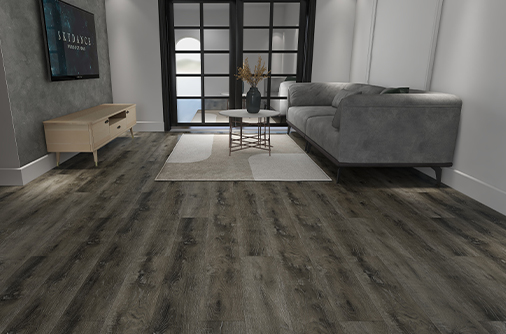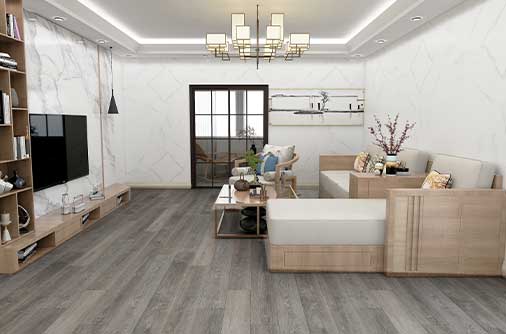In today's rapidly evolving interior decoration industry, flooring materials are undergoing an ever-increasing evolution. LVT Luxury Vinyl Flooring is becoming an essential choice for residential, commercial, and office environments. With its superior physical properties, diverse design options, and excellent value for money, LVT flooring is no longer just an "upgrade" to traditional PVC flooring; it is now a core force leading the modern flooring revolution.
Innovative Structural Processes, Redefining Durability
The advantages of LVT flooring stem primarily from its unique multi-layer structure. It typically consists of five layers: a UV wear-resistant layer, a transparent wear-resistant layer, a printed decorative layer, a base layer, and an underlayment. Each layer plays an essential role. The wear-resistant layer, which is crucial, not only determines the floor's lifespan but also directly impacts its performance in high-use environments. Modern LVT products utilize nano-coatings and high-density transparent PVC materials to make their surfaces not only scratch-resistant and abrasion-resistant, but also antibacterial and stain-resistant, significantly enhancing the overall durability and safety of the product.
The stability of the base layer is also crucial. In LVT flooring manufacturing, the use of fiberglass reinforcement significantly reduces thermal expansion and contraction, ensuring the floor maintains excellent shape stability even in complex temperature and humidity environments. Some high-end LVT products incorporate sound-absorbing and shock-absorbing materials in the underlay, effectively mitigating the impact of footsteps and falling objects on the spatial environment. This makes them particularly suitable for use in places with strict noise control requirements, such as hospitals and libraries.

A Deep Integration of Visual Aesthetics and Simulation Technology
Unlike the monotonous plastic-like flooring of the past, LVT's core competitiveness lies in its astonishing visual simulation capabilities. By combining high-precision printing and embossing technology, LVT flooring can realistically reproduce the texture and feel of various materials, including wood, stone, ceramic, and even fabric. This delivers not only visual beauty but also exceptional tactile fidelity. In terms of design trends, LVT offers a full range of styles, from Nordic wood to industrial metal, perfectly satisfying the diverse and personalized aesthetic needs of contemporary consumers.
In the current market, with the continuous maturation of digital printing technology, the update cycle of LVT flooring patterns is becoming increasingly shorter. Many brands have even launched customized services, making LVT not just a building material but also an integral part of the interior design language. Advances in embossing technology have further expanded its tactile dimension. Utilizing EIR (Energy Integral Recognition) technology, the surface texture of LVT flooring can be precisely aligned with the printed pattern, creating a more realistic three-dimensional texture.
Optimized installation systems are driving diverse application scenarios.
LVT flooring installation methods are also constantly evolving, from the initial adhesive-based method to the more popular snap-on and loose-lay methods, significantly impacting both construction efficiency and the environment. Snap-on LVT flooring utilizes a precise tongue-and-groove structure, eliminating the need for glue during installation. This simplifies the process, reduces the release of volatile organic compounds, and further supports green construction concepts. Loose-lay products, on the other hand, utilize a combination of gravity-supported design and a non-slip backing, offering excellent dimensional stability and enabling quick replacement. They are suitable for applications requiring high flexibility, such as short-term showrooms, temporary spaces, or rentals.
These innovative installation methods have made LVT flooring more widely applicable in a variety of spaces, from residential to commercial, from flooring to wall decoration. Its convenient installation cycle and low maintenance costs are particularly attractive to designers and clients in retail, education, healthcare, and hospitality spaces.

Green and sustainable development is a key technical direction.
Against the backdrop of the "dual carbon" initiative, sustainable development has become an industry consensus in the building materials industry. The environmental performance of LVT flooring is also a key factor in its mainstream adoption. Many LVT products now utilize phthalate-free formulas and comply with environmental certifications such as EU REACH and US FloorScore, ensuring they are harmless to human health during daily use. Furthermore, its increasing recycling rate makes LVT a preferred material that combines commercial value with environmental responsibility.
The rise of LVT luxury vinyl flooring is no accident, but rather the result of a combination of factors. From process and performance to design, environmental protection, installation, and market penetration, LVT has undergone systematic optimization and breakthroughs in nearly every key aspect. In the future, with the upgrading of consumption and the in-depth promotion of green construction, LVT will not only continue to refresh people's understanding of floor materials, but is also expected to become an important medium for expressing the new generation of interior spaces.


 English
English 中文简体
中文简体 русский
русский Español
Español




